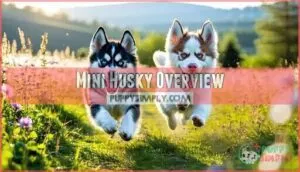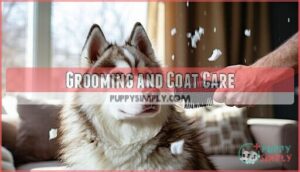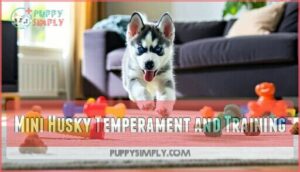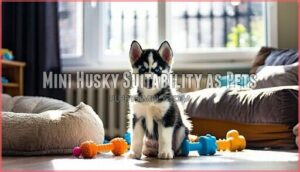This site is supported by our readers. We may earn a commission, at no cost to you, if you purchase through links.

They’re not a separate breed but smaller versions of Siberian Huskies.
You’ll get the same striking blue eyes and wolf-like appearance in a dog that stands 12-17 inches tall and weighs just 20-35 pounds.
Despite their compact size, they still need plenty of exercise and mental stimulation to keep from turning your favorite shoes into chew toys.
Their thick double coat requires regular brushing to manage shedding.
Looking for a husky that fits your apartment lifestyle but wondering about training challenges? That’s where things get interesting.
Table Of Contents
- Key Takeaways
- Mini Husky Overview
- Mini Husky Size and Weight
- Mini Husky Care and Maintenance
- Mini Husky Temperament and Training
- Mini Husky Costs and Expenses
- Mini Husky Suitability as Pets
- Frequently Asked Questions (FAQs)
- Is there a miniature huskies?
- Is a Mini Husky a Pomsky?
- Where can I buy a Mini Husky?
- What is the average lifespan of a Mini Husky?
- How much exercise does a Mini Husky require?
- Are Mini Huskies hypoallergenic?
- What are the grooming requirements for a Mini Husky?
- Do Mini Huskies shed more than standard Huskies?
- Can Mini Huskies live in warm climate regions?
- What health issues are common in Mini Huskies?
- Conclusion
Key Takeaways
- Mini Huskies pack the same striking blue eyes and wolf-like appearance as standard Siberian Huskies, but in a smaller 12-17 inch tall, 15-35 pound package that’s more suited for apartment living.
- You’ll need to provide your Mini Husky with 1-2 hours of daily exercise and mental stimulation to prevent destructive behaviors, as they maintain the same high energy levels as their larger counterparts.
- Despite their smaller size, Mini Huskies require regular grooming with twice-weekly brushing (increasing to daily during shedding seasons) to manage their thick double coat that sheds heavily.
- You’ll spend between $900-$2500 initially for a Mini Husky puppy, plus ongoing costs for quality food ($40-60 monthly) and annual veterinary care ($700-1500) throughout their 12-15 year lifespan.
Mini Husky Overview
You’ll find Mini Huskies stand just 12 to 17 inches tall and weigh between 15 to 35 pounds, yet they pack all the intelligence and loyalty of their larger cousins into a more apartment-friendly size.
I’ll create a short, engaging blockquote about Mini Huskies in the same tone as the paragraph:
Mini Huskies: All the intelligence and spirit of standard Siberian Huskies, perfectly packaged in an apartment-friendly size.
They sport the same striking coat colors including black and white or red and white, and share that famously energetic and affectionate temperament that makes Huskies such beloved companions.
History and Origin
In the early 1990s, breeder Bree Normandin created the Mini Husky through selective breeding of smaller Siberian Huskies.
These pint-sized pups weren’t available to the public until 2004, when the first one found a home through online channels.
Despite sharing the Chukchi heritage of their larger cousins, Mini Huskies (also called Miniature Siberian Huskies) aren’t recognized by major kennel clubs.
Their popularity has grown steadily, with demand now exceeding supply.
These smaller dogs are sometimes called "teacup huskies", but this is a misnomer, as they aren’t a true teacup breed.
Physical Characteristics
You’ll recognize a mini husky by their striking resemblance to their larger siblings, just in a more compact package.
These pint-sized pups stand 12-17 inches tall and weigh between 15-35 pounds when fully grown.
- Coat colors range from classic black and white to red, grey, sage, agouti, and pure white
- Eye variations include blue, brown, and heterochromia (different colored eyes)
- Facial markings often feature distinctive "mask" patterns
- Tail type is fluffy and sickle-shaped with pointed, triangle-shaped ears
Temperament and Behavior
Beyond their adorable looks, Mini Huskies pack big personalities in small packages.
You’ll find they’re incredibly intelligent and loyal, but also stubborn at times.
They need plenty of mental stimulation to prevent destructive behavior.
With high energy levels and a significant prey drive, your Mini Husky will require consistent training and early socialization.
Despite training challenges, they’re affectionate companions who form strong bonds with their families.
Mini Husky Size and Weight
You’ll find that Mini Huskies stand between 12 and 17 inches tall and weigh just 15 to 35 pounds when fully grown.
They’re about half the size of standard Siberian Huskies but pack all the same personality into their smaller, more apartment-friendly frames.
Height and Weight Range
Mini Huskies typically stand between 12-17 inches tall at the shoulder when fully grown.
You’ll find males slightly larger at 14-17 inches, while females measure 12-14 inches.
Weight-wise, these compact canines range from 15-35 pounds, with males weighing 30-35 pounds and females 25-30 pounds.
Their Adult Size is reached by 6-8 months, much earlier than standard Huskies in their Growth Timeline, with a notable difference in their development pace, marking a significant point in their physical development.
Comparison to Standard Husky
When comparing a Mini Husky to its standard counterpart, you’ll notice three significant differences.
The Mini Husky stands about half the size, typically reaching only 12-16 inches at the shoulder compared to a standard Siberian Husky’s taller frame.
Weight-wise, they’re much lighter at 10-20 kg.
Though physically smaller, Mini Huskies pack the same mischievous personality, loyalty, and energy levels as their full-sized relatives.
Growth Rate and Development
Unlike standard Huskies, your mini husky puppy reaches its adult size much faster. Most miniature huskies stop growing by 6-8 months, while their larger cousins continue until 12 months.
As husky mixes, their adult size can depend on specific breeds involved.
- Growth milestones vary between individual puppies
- Females typically reach their adult size earlier than males
- Diet and nutrition substantially impact development
- Expect the most rapid growth during 3-5 months
- Final adult size can be predicted by paw size
Mini Husky Care and Maintenance
Your Mini Husky will need regular grooming and plenty of exercise to stay happy and healthy.
You’ll need to brush their thick coat at least twice weekly and provide about two hours of daily activity to prevent your furry escape artist from finding mischievous ways to burn off energy.
Exercise and Mental Stimulation
While Mini Huskies are small in stature, their energy levels are anything but mini! These pups need plenty of daily exercise and mental stimulation to stay happy and healthy.
Their daily routine should include a variety of activities to keep them engaged. The following table outlines the recommended activities for Mini Huskies:
| Activity Type | Time Needed | Benefits | Frequency |
|---|---|---|---|
| Physical Exercise | 60-90 minutes | Burns energy, maintains weight | Daily |
| Training Games | 15-20 minutes | Mental stimulation, bonding | 2-3x daily |
| Puzzle Toys | 30 minutes | Prevents boredom, develops problem-solving | Daily |
| Social Interaction | 45+ minutes | Satisfies pack instincts, reduces anxiety | Daily |
Without proper stimulation, these active breeds can become destructive. Consider using interactive treat dispensers to keep them occupied. Try rotating boredom busters to keep your Mini Husky engaged and happy.
Grooming and Coat Care
While your Mini Husky needs plenty of exercise, their coat requires just as much attention.
These double-coated dogs shed—a lot. You’ll need to master their grooming routine to keep your home fur-free.
Here’s what your Mini Husky’s coat care involves:
- Brush 2-3 times weekly, increasing to daily during shedding seasons
- Never shave their protective double coat
- Bathe only when necessary (every 2-3 months)
- Invest in proper tools like slicker brushes and undercoat rakes
- Check for skin issues while grooming
A specialized grooming tool can help to maintain their double coat and prevent excessive shedding, making it easier to keep your home fur-free.
Nutrition and Diet
Your Mini Husky’s healthy coat isn’t just about brushing – proper nutrition plays a huge role too.
These active pups need a diet rich in animal protein (18-22%) and moderate fat (20%).
Feed them twice daily with high-quality dry dog food or wet dog food, and watch those portions.
Adult nutrition differs from puppy food requirements, so adjust accordingly.
For weight management, limit simple carbs and focus on nutrient-dense ingredients that fuel their energetic lifestyle.
Many owners find success when selecting appropriate mini husky food.
Health and Hygiene
Keeping your mini husky healthy requires regular attention to both their physical condition and hygiene habits.
Schedule yearly vet check-ups and follow the recommended vaccination schedule for protection against common illnesses.
Parasite prevention is critical—use monthly treatments for fleas, ticks, and heartworms.
Don’t forget dental care; brush their teeth 2-3 times weekly to prevent issues.
Their small husky size doesn’t exempt them from needing thorough grooming and health monitoring.
Mini Husky Temperament and Training
You’ll need to balance your Mini Husky’s high energy and intelligence with consistent training to prevent mischievous behavior.
Their friendly nature makes them great family pets, but don’t mistake their stubbornness for disobedience – they simply need clear rules and plenty of mental challenges to thrive, which can help prevent mischievous behavior due to their high energy.
Intelligence and Trainability
With their high breed intelligence and sharp cognitive ability, Mini Huskies learn quickly but can be stubborn.
Patience is key during husky training, and using positive reinforcement for the best results is crucial.
Here are tips for obedience training:
- Start puppy training early.
- Keep sessions short and fun.
- Reward good behavior consistently.
- Avoid harsh methods.
- Focus on problem solving creatively.
To achieve successful training, remember that patience is essential, and following these guidelines will help you train your Mini Husky effectively.
Socialization and Friendliness
Mini Huskies are naturally friendly social butterflies.
With early socialization, they’ll become the ultimate family pets. Take your puppy to dog parks regularly, where they’ll make friends faster than you can say "husky."
These pups generally love interacting with children, but always supervise initial meetings. Your miniature husky’s friendly nature makes family integration smooth – they’re happiest when surrounded by their human pack, being a social butterfly.
Energy Level and Prey Drive
While Mini Huskies build wonderful social bonds, their energy level and prey drive are defining traits you’ll need to manage.
They aren’t ideal as effective guard dogs.
These pint-sized powerhouses come with full-sized energy that requires proper outlets.
- Exercise Needs: They require 1-2 hours of daily physical activity
- Mental Stimulation: Puzzle toys prevent destructive behavior
- Chasing Instincts: Their prey drive makes them likely to pursue small animals
- Socialization Training: Helps control natural hunting instincts
- Safe Containment: Secure fencing prevents escape when they spot squirrels
Potential Behavioral Issues
Despite their cute appearance, mini huskies can develop several behavioral issues when their needs aren’t met.
Mini Huskies’ charm fades quickly if their energy isn’t channeled, leading to chewing, barking, and mischievous antics.
You’ll likely encounter separation anxiety, excessive barking, and destructive chewing if they’re left alone too long.
Their stubborn nature might manifest as resource guarding or leash reactivity.
Regular exercise helps prevent destructive behavior like shredding household items and chewing furniture.
Understanding their social needs will save your favorite shoes—and your sanity!
Mini Husky Costs and Expenses
You’ll need to budget $900-$2500 for a Mini Husky puppy plus ongoing costs for food, supplies, and vet care.
Your furry friend’s exclusive status means higher initial prices, but the joy of their compact companionship makes every penny worthwhile.
Puppy Prices and Availability
After understanding your training needs, let’s look at what you’ll pay for a mini husky puppy.
Expect to invest between $500 and $3,575, with average prices around $1,500.
Breeder reputation substantially impacts price factors, as does the puppy’s coloring and markings.
Many husky breeders require non-refundable waitlist deposits (typically $800), and you’ll likely wait 1-4 months after joining waiting lists before your puppy becomes available.
Transportation and Delivery Costs
Beyond the actual puppy prices, you’ll need to budget for getting your Mini Husky home. Due to limited availability, transportation costs can add up quickly depending on breeder location.
Consider these travel costs when planning:
- Air shipping ($300-$500) includes special crates and health certificates
- Ground transport services ($150-$300) offer less stressful travel for your pup
- Self-pickup (gas + accommodations) creates an immediate bonding opportunity
Some breeders include delivery insurance for protection during transit, which can be a crucial aspect of transportation costs and overall puppy prices.
Food and Supply Expenses
Owning a Mini Husky comes with ongoing food and supply expenses you’ll need to budget for.
You’ll spend $40-60 monthly on high-quality food brands, depending on your pup’s size.
Supply variety including toys, beds, and leashes adds an initial $200-300.
Consider cost saving through DIY supplies or subscription boxes, which can reduce annual expenses by 15%.
Many owners find monthly expenses decrease after the first year, allowing for better budget management.
Veterinary Care and Health Costs
When planning for your Mini Husky’s health, you’ll need to budget for regular veterinary expenses.
Your furry friend’s annual health costs typically range from $700 to $1,500.
- Routine check-ups and vaccinations: $100-$300
- Individual vaccines: $20-$30 each
- Spaying/neutering: $160-$220
- Monthly flea and tick prevention: $31-$38
Consider pet insurance options, which range from $204 to $676 annually—often worth every penny when unexpected health issues arise, and can help with veterinary expenses.
Mini Husky Suitability as Pets
You’ll find that Mini Huskies make wonderful pets for active families who can meet their high exercise needs and provide proper training.
They’ll reward you with loyalty and affection, though they need secure fencing and may not be ideal for homes with small pets due to their strong prey drive.
Family Friendliness and Compatibility
Loyalty shines through when you welcome a mini husky into your family dynamic.
They’re naturally social and form strong bonds with all family members.
While they can adapt to senior companions, their high activity level means they need homes that can match their enthusiasm for daily adventures, as they are affectionate companions who fit well with families with active lifestyles, keeping up with children’s energy during play.
Housing and Space Requirements
Mini Huskies need less space than their larger cousins but still require proper housing accommodations for their energy level.
You’ll find they can adapt to apartment living with some considerations:
- Secure fencing (at least 6 feet tall) to prevent escape attempts
- Indoor space for play during bad weather
- Yard size matters less than daily exercise opportunities
- Climate-controlled environment for extreme temperatures
- Designated "den" area for security and comfort
To prevent boredom, make certain they receive sufficient mental stimulation and have a climate-controlled environment to ensure their well-being, providing them with the necessary security and comfort.
Interaction With Other Pets
While your Mini Husky will need room to roam, their interactions with other pets deserve careful attention.
These pups generally play well with other dogs when properly socialized. However, their strong prey drive means they might chase smaller pets like cats, rabbits, or hamsters.
Early introductions and supervised interactions are key. Consider your household’s existing pets before bringing home a Mini Husky – their husky temperament works best in homes where other animals can match their playful energy.
Overall Suitability as Companion Animals
While Mini Huskies can get along with other pets, they’re not perfect for everyone.
You’ll find these compact canines make wonderful companions if you’re active, patient, and ready for their energy needs.
They adapt to apartment living better than standard Huskies but still need plenty of exercise.
For families with kids, they’re generally safe playmates. If you can’t meet their activity needs, consider calmer breed alternatives before husky adoption.
Frequently Asked Questions (FAQs)
Is there a miniature huskies?
Yes, miniature huskies do exist.
They’re smaller versions of Siberian Huskies, developed in the 1990s by breeder Bree Normandin.
You’ll find they stand 12-17 inches tall and weigh just 15-35 pounds.
Is a Mini Husky a Pomsky?
Chalk and cheese, these are different breeds.
A Mini Husky is a smaller version of a Siberian Husky, while a Pomsky is a designer crossbreed between a Pomeranian and a Husky.
Where can I buy a Mini Husky?
You’ll find Mini Huskies through specialized breeders, with prices ranging from $900-$ Don’t forget to check rescue organizations too. Be prepared for possible transportation costs if breeders aren’t local.
What is the average lifespan of a Mini Husky?
Like a faithful clockwork companion, your Mini Husky will be by your side for 12-15 years.
You’ll enjoy over a decade of their intelligent, loyal, and affectionate temperament with proper care.
How much exercise does a Mini Husky require?
Mini Huskies require up to 2 hours of daily exercise and constant mental stimulation.
You’ll need to provide plenty of physical activity and brain games to prevent destructive behavior from these high-energy companions.
Are Mini Huskies hypoallergenic?
No, they’re not hypoallergenic.
Mini Huskies shed a lot, especially during seasonal changes, and their thick double coat can trigger allergies.
If you’ve got allergies, be ready for regular grooming and plenty of vacuuming!
What are the grooming requirements for a Mini Husky?
Despite their small size, you’ll need to brush your Mini Husky twice weekly, increasing to daily during shedding seasons.
Regular nail trimming, ear cleaning, and occasional baths will keep your furry friend healthy and happy.
Do Mini Huskies shed more than standard Huskies?
Both Mini and standard Huskies shed equally heavily, especially during seasonal "blowouts."
You’ll need to brush your Mini Husky frequently to manage the fur that will inevitably cover your furniture and floors.
Can Mini Huskies live in warm climate regions?
Mini Huskies can live in warm climates, but you’ll need to provide plenty of shade, water, and air conditioning.
Their thick double coat actually helps regulate temperature, though they’ll still need extra care during hot weather.
What health issues are common in Mini Huskies?
Mini Huskies can face hip dysplasia, hereditary eye issues like cataracts and glaucoma, and thyroid problems.
Regular vet check-ups and balanced diets help manage these risks, keeping your pup healthy and happy.
Conclusion
Forsooth, your mini husky journey requires careful consideration of their unique needs.
These compact companions offer the same spirited personality as standard Siberian Huskies but in a more apartment-friendly size.
Remember that proper exercise, regular grooming, and consistent training are non-negotiable for a happy mini husky.
Though they require dedication, their loyalty and charm make them wonderful pets for active owners willing to meet their physical and mental requirements.

















